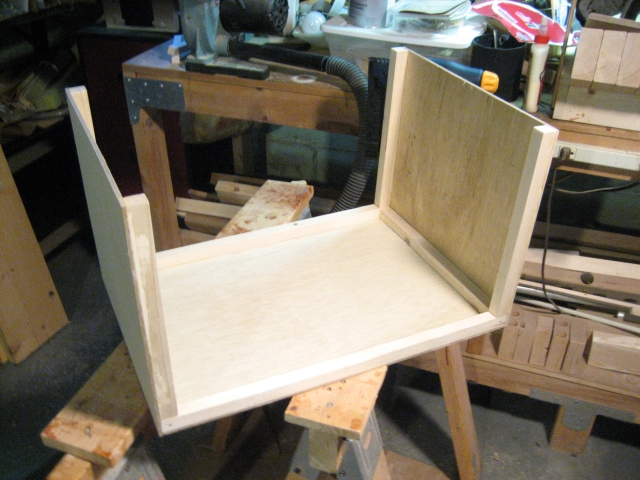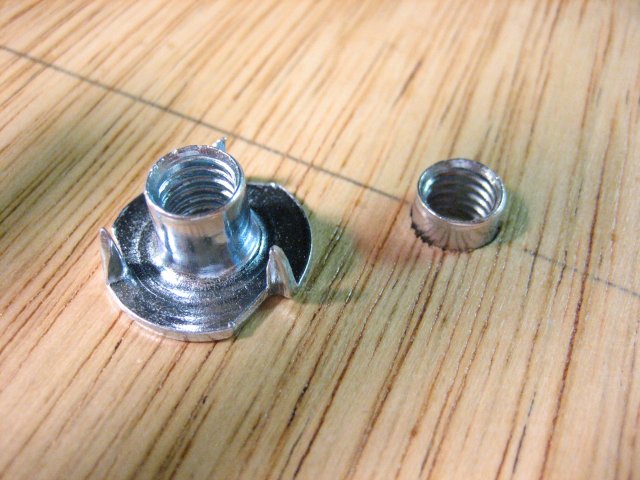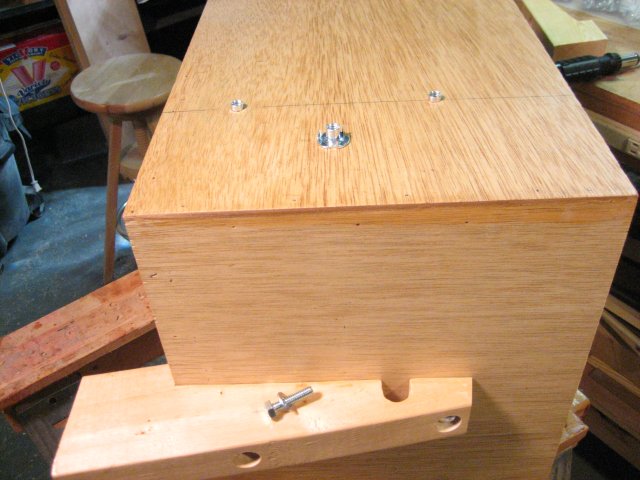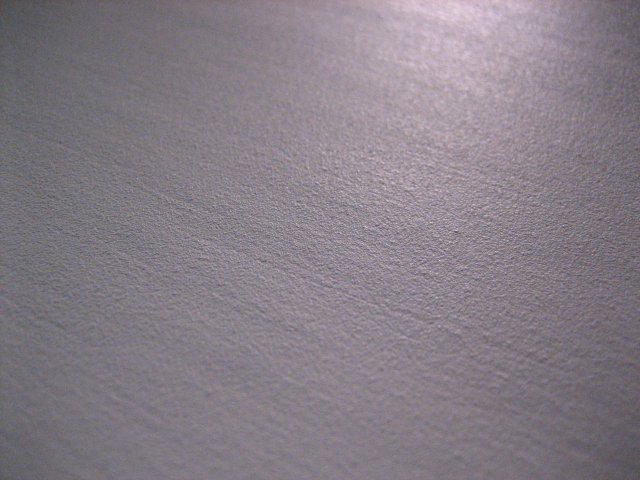Storage Karabitsu
No More "Tucker Totes"

July 2007

July 2007
Please believe me when I tell you that I did not intend to make five karabitsu. I was going to make three identical ones, but that became four, so we'd have a larger one to store the propane stove. The "fourth" was actually built second, and it came out a little small for its intended use, so I had to try again. I built the fifth at the same time as the second and third. The fifth (which is the second fourth) came out OK. Whew.
Anyway, these karabitsu are intended mostly as general storage containers for us to take up to Pennsic where we camp with a Japanese themed group. We, like many people, make heavy use of "tucker totes" (plastic storage containers) for outdoor storage at Pennsic. Plastic totes are great; they're cheap, waterproof, and lightweight, but they were looking increasingly ridiculous next to our nice canvas medieval pavillion. Having made a couple of Karabitsu (1, 2) before, I knew they were handy and reasonably simple to make. They seemed like a good replacement for our totes.
The only down side is that with the legs, the karabitsu don't pack into the car as easily as plastic totes. I solved this problem by having the legs be removable on the karabitsu that I'm keeping. Bolts run through the legs from the outside and connect to "T-Nuts" in the body of the chest, so the legs can be attached or detached from outside the karabitsu without unpacking it.
My box bodies are constructed entirely of exterior-grade 5.2 mm Lauan plywood. You should be able to find this a a large chain hardware supermarket like the Home Despot or Lowe's. This plywood is about 3/16 of an inch thick, and has been treated to resist moisture. The lids are edged in 1x3 pine board, which is actually about 0.75"x2.75". Since I used such thin plywood, the box bodies are framed internally in pine 1x1. If you don't have a pile of scrap wood, I recommend buying 1x4 for the lid edges, and trimming the extra 3/4" off to make 1x1 framing. Get a couple extra feet of 1x4 so you can turn that into 1x1 as well.
The legs on my boxes are made from 2x4. Each leg needs at least 13 inches of 2x4 (more if you're making a taller box). If your karabitsu will have the detachable legs, you will need 5/16" by 1" hex head bolts, 5/16" by 3/8" tee nuts, and 5/16" flat washers in sufficient quantity (two each per leg).
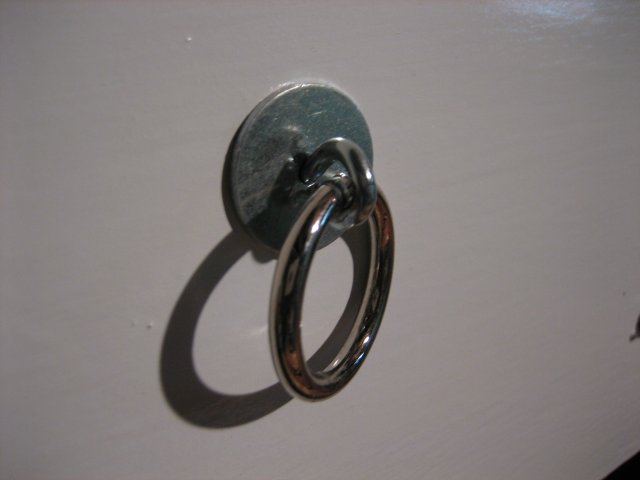
If you're making a six-leg karabitsu, and want to make the ring hardware, buy a couple of chrome rings in the chain section (I used 1" rings) (I could only find these at Lowe's), and some screw eyes with eyes that fit them (I used 3/16" screw eyes) (if you can find them, you might want eye bolts instead) in the hardware section. Also buy the largest fender washers you can find that have holes that fit the threaded portion of your eye hardware.
You're also going to need plenty of sand paper (I get away with some 120 and some 220 grit. If you're going for super-smooth and glossy, add some 320 or maybe even higher.) a reasonable amount of wood filler (aka "wood putty"), probably about 75 wire brads, (3/4" is probably best.) a quart of exterior sealer or primer, (I used a Glidden all purpose primer mixed with an insulating additive.) a quart of exterior paint (I use Rustoleum gloss enamel paint), at least one all purpose paint brush (I use those cheap China bristle brushes. They only last one project, but I can make them last the whole project.)
For tools, if you want to do this my way, you're going to need a table saw, miter saw, band saw, drill press, nail gun, finishing sander, drill/driver, jig saw, nail set, and hammer. If you don't have all those fancy tools, you can probably get away with just having a circular saw and a hammer, but you'd better know what you're doing.
A note about the insulating additive in the primer: The primer I used on the white karabitsu had an insulating compound mixed into it which supposedly reduces heat absorption in the sun by about 20%! Some friends of mine turned me on to the stuff. They used it to repaint a brick pantry on the back of their house (canned goods were freezing in the winter) and they told me it worked great.
It's just a very fine ceramic powder (supposedly, the grains are hollow micro spheres) that you mix into any paint. It adds a slight texture like fine sand paper that is still visible even after a couple of coats of plain paint, so it's not perfect, but it's not too bad. I mixed it into the primer coats on the karabitsu for both the inside and outside, so technically there were four coats insulating the boxes. Even sitting out in the sun they never got steamy hot inside the way the plastic totes did.
If you do a web search for "insulating paint additive", you should be able to find a number of different companies selling it. I bought from http://www.insuladd.com/ where it costs $12 to $15 for enough to add to a gallon of paint. You can probably find it cheaper if you hunt around.
First, do some planning. Download this PDF Karabitsu worksheet, and print it out. The first page is your worksheet for making custom-szed boxes. The second page shows the dimensions I used for the third and fourth boxes I made. The last page shows the shape of the legs. More on that later.
Decide what dimensions you want for your karabitsu, and plug those dimensions in a X, Y, and Z. "X" is the width of the box body. "Y" is the length of the box body. "Z" is the height of the box body. These are roughly the external dimensions of the box. Keep in mind that the inside will be slightly smaller, and that there will be framing inside. If you have something specific (like a cooler) that you need to fit in the karabitsu, make sure to compensate for these things when you compute size.
The suggested lid dimensions yield a very loose lid. You can probably cut about a quarter inch off everything, but be careful not to make the lid too tight. I like the looser lids so that it's easy to take them off and put them on. Trying to get tight lids exactly lined up in the dark can be something of a pain. Also, don't forget that you will be painting the box. A lid that fits snugly before finishing will be way too tight after few coust of paint.
Once you have everything planned out, you can start cutting. I use a 200 tooth plywood blade in the saw, which keeps "tear out" to a minimum and leaves relatively smooth edges on all the cuts. Since you're cutting very thin plywood, be careful with your fingertips, and be carefult to keep cuts as straight as possible.
I tend to cut pieces with the long dimension following the external grain of the plywood. This means horizontal grain on the long sides of the box. Whether or not the grain is horizontal on the ends depends on the size of the box. I'm an efficiency freak, so I try to start with my narrowest cuts and work my way up, cutting panels to width and then to length. For instance, cutting a panel to the width of Z, then trying to get both long sides out of that. It's not always possible, though. If you plan well and your karabitsu is not too large, you can get all your pieces out of half a sheet of plywood.
If you're bringing the plywood how from the store in a smaller car, you can often have the sheet cut into smaller panels there. If you can convince the sometimes surly cutting person to do it, have the 4'x8' sheet of plywood cut into sixths. Have it cut in half sideways, then into thirds about 16" wide. This is only three cuts if the cutter stacks the halves. These 16"x48" panels are a handy size for most medium sized karabitsu. Buying a full sheet for $10 and having it cut is much more economical than buying 2'x4' "handy panels" for $4.50 apiece. Don't worry about getting extra; you can use use this plywood for all kinds of stuff.
Once you have the plywood cut, it's time to cut the lid edges. As noted above, I get 1x4 and trim off 3/4" to make some useful 1x1 scrap. With that done, I cut a rabbet 3/16" wide and 3/8 of a inch deep all the way down one edge of the boards. This rabbet will allow the lid plywood to be securely attached and enclosed within the edges. You don't need a dado set for this, I just run the board past a normal blade twice. If you want to get fancy, cut the channel for the rabbet first, then trim off the extra wood.
After that, cut the lid edges to length. Cut two of each length, of course. After that bevel the edges to 45 degrees. A power miter saw is really helpful, but be careful not to miter your precious fingers.
Lastly, cut the legs. Figure out how many legs you need, four or six, then cut that many lengths of 2x4. For this project, I cut all my legs the same length so that they would be interchangeable between karabitsu. In general, you want to start with the height ("Z") of your box body, subtract the width of your lid edges, add the amount of space you'd like under the box (My boxes sit three inches of the ground), then add one inch to compensate for the beveling.
Now, bevel the leg ends. Bevel the top at 20 degrees, and the bottom at 10 degrees, as shown on page 3 of the PDF. It's helpful to label the edges of the first one you cut (front, back, top, bottom) so you can keep track of which way everything goes. I use a miter saw for all of this cutting and beveling. If you're good, you can probably do both steps at the same time, but I find it helpful to separate the steps.
Finally, cut the "notch" on the back side of each leg. This notch is what the body of the karabitsu will "sit" in. I measure three inches up from the bottom inner corner, then draw a 1 inch line towards the front, parallel to the bottom edge. Then, I draw a perpendicular line upwards from the end of that line that goes all the way up to the top edge. Lastly, I cut out this notchy bit on the band saw. Since I was making 26 of these total, I built a sliding jig for the band saw to make sure all my cuts were the same.
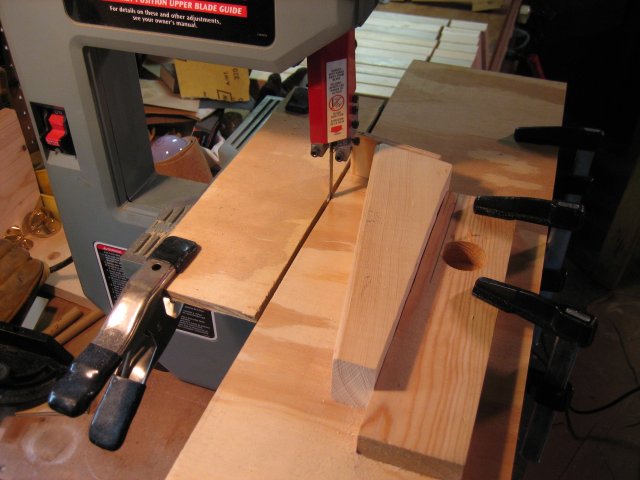

Once the legs are the right shape, it's time to cut pass-throughs for the ropes. These pass-throughs admit rope that you can use to carry the karabitsu or tie down the lid.
If you're not making the removable legs, you don't have to worry about this next bit. Drilling the holes for the leg bolts is a huge pain. Unless you want to have to keep track of which legs go where, all the holes have to be drilled as identically as possible.




